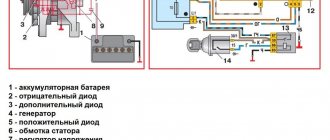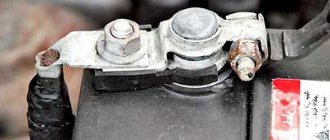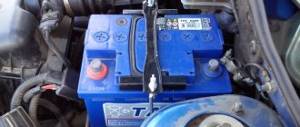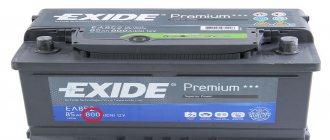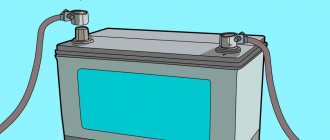Causes of oxidation of battery terminals
Problems associated with poor contact are the most common cause of failure of any electrical equipment. The appearance of oxides on the battery contacts harms the vehicle's electrical equipment and may indicate problems with the battery.
A small oxide on metal surfaces inevitably appears as a result of the interaction of their surface with atmospheric oxygen and other reagents. Therefore, even very high-quality electrical contact deteriorates over time due to natural oxidation processes. In addition, if the contacts are made of different metals, a galvanic potential difference arises between them, which also leads to premature oxidation of the surface.
If additional aggressive factors appear or the terminals are improperly fixed, conductivity disturbances and oxides of the contact pads can very quickly occur.
Excessive oxidation of car battery terminals typically occurs for four reasons:
- aggressive effects due to leakage of electrolyte vapors from the body of a damaged battery (electrochemical corrosion) - this oxide is white;
- poor contact at the junction of the battery terminals with the vehicle conductors due to poor tightening, high humidity in the engine compartment and dirt getting into the unfixed gap, which leads to sparking and burning of the contact point, leading to blackening;
- humidity in the engine compartment oxidizes the copper contained in the terminal - this causes a greenish coating and rust;
- The battery contact is made of lead, and the car's electrical wiring conductor is made of another metal (copper or brass), which leads to a chemical reaction between them - the color of the oxide may be greenish.
Oxides that appear for these reasons can appear on both electrodes of the battery. Due to slight design differences between these contacts, the frequency of their appearance on each electrode varies slightly.
Why does the positive terminal on the battery oxidize?
The positive terminal on most cars is covered with a plastic cover, which allows condensation to accumulate under it. If the battery is poorly sealed from exposure to high temperatures during engine operation, as well as when it is heavily overcharged, electrolyte vapors leak. Acid particles from these vapors eventually concentrate under the insulating cover in the area of the positive terminal and lead to its oxidation.
At the same time, due to the fact that the positive electrode is covered with a cover, less external contaminants enter the connection point, which reduces the likelihood of poor contact, sparking and associated blackening.
Thus, on the positive side, the appearance of white oxide is likely due to the leakage of electrolyte vapors.
Why does the negative terminal of the battery oxidize?
The negative terminal of the battery is more susceptible to external influences because it does not have a protective cover. Because of this, acidic vapors of the electrolyte condense less on it, but more dust and dirt enter. All this leads to faster deterioration of the electrical contact of the battery cathode with the wiring, the occurrence of small spark discharges during engine starts, which ultimately lead to burnout and blackening of the contact surface.
These problems most often appear when the battery is connected to initially dirty contacts and when they are loosely tightened.
Reasons for contact heating
There are several main reasons why the positive or negative terminal on the battery gets hot.
It is important to understand the peculiarities of how a car operates with a battery. When the key is turned in the ignition, the starter is engaged and this allows the engine to start. When starting, a large starting current is transmitted. In some cases, these figures are an impressive 600 Amps.
If there are certain problems, this leads to heating of the battery terminals and terminals.
Experts identify several probable reasons why battery terminals heat up. And both negative and positive.
- Poor quality of contact between the terminal and the battery terminal. These are quite common reasons, due to which the battery terminals often get very hot. This usually happens after long-term use, or it appears on relatively new machines due to a manufacturing defect.
- Formation of oxides on the inner surface of contacts. The negative terminal, like the positive terminal, sometimes heats up due to the appearance of an oxidation film. A common problem with lead-acid batteries. To prevent the appearance of oxides, it is recommended to periodically check the condition of the leads, clean them with brushes or treat them with special sprays.
- Increased resistance of conductors. The probable cause of heating is the positive terminal of the car battery. In this case, it is worth checking the condition of the battery wires. When operating a car, it happens that the wires are refracted. Because of this, conductivity indicators drop, and the passing current contributes to an increase in temperature. In this situation, there are not many options for solving the problem. The damaged wire needs to be replaced.
- Lost connection with the housing. If, when you start the engine, it is the negative terminal from your battery that heats up, pay attention to the quality of the connection between the negative terminal and the vehicle body. In such situations, heating of both the terminal itself and the wires is possible.
- Battery malfunctions. They can provoke oxidation of the terminals and internal surfaces of the terminals and disrupt switching. But in such a situation, the positive terminal will heat up. The solution is simple. This includes cleaning the metal components, as well as replacing the battery itself. You cannot connect a new battery to faulty terminals.
Having figured out the reasons, they will need to be eliminated.
A number of problems can be solved by the motorist himself. But sometimes it is wiser and more logical to turn to specialized specialists.
Before you get started, it is important to understand the dangers of heating.
What can oxidation of terminals lead to?
Over time, the resistance at the site of the oxidized contacts becomes so large that most of the battery current is lost there, and the starter cannot turn. In this regard, it will be impossible to start the car engine.
The metal of oxidized terminals becomes chipped, the contact surface area decreases, which will worsen the conductivity even after cleaning them and will contribute to the faster appearance of oxides during further operation. Therefore, it is necessary to regularly visually inspect the battery terminals and carry out preventive measures related to the elimination of bad contacts and deposits by cleaning them, as well as lubricating the terminals to protect them from oxidation.
If a whitish acid deposit appears due to a violation of the integrity of the battery case, then it is necessary to replace it. This is due to the fact that cracks in the battery case from vibrations and shocks during vehicle operation will only increase over time, which will lead to acidic electrolyte entering the engine compartment with the ensuing disastrous consequences.
The appearance of a green coating on the contacts may indicate increased humidity where the car is parked, which can lead to corrosion of its other metal parts.
Difference between oxidation of different terminals
When checking the condition of the battery, motorists have various questions.
For example, many are interested in why it is the negative terminals of batteries that oxidize, but nothing happens to the positive terminals, or the oxides on them are minimal.
There is also the opposite situation, when the positive terminals of the batteries oxidize, but the negative terminals remain untouched by these phenomena.
There really is no significant difference. It is important to understand here that the terminals for connecting to the battery terminals are made of the same material. Yes, sometimes they are different sizes to match the diameter of the plus and minus on the battery case. But it doesn’t matter to the electrolyte whether it’s plus or minus.
Oxidation becomes a consequence of the launch of a chemical process caused by the contact of a liquid, and a very aggressive one, with metal.
The only exceptions include situations where the connection density is broken. In this case, the minus will bear the main load. Therefore, if your minus is heavily oxidized, but your plus is almost undamaged, it would not be superfluous to check the strength of the connection.
How to identify signs of terminal oxidation
Oxidation of battery contacts can be determined both by visual inspection and by indirect signs associated with a decrease in starting current at the car starter and a decrease in the brightness of lighting devices.
A visual inspection is associated with the search for microcracks, loose electrodes, traces of electrolyte leakage, and the presence of dirt on the ventilation holes. If you are confident that the battery is fully charged, but the starter turns the engine weakly, the cause may be poor contact with the battery.
In order to determine whether the whitish deposit is acidic, you need to remove the battery from the car and, using protective gloves, wash the contacts and battery housing with a weak solution of soda (up to 10%) in warm water, and then wipe it dry. When an alkaline solution comes into contact with an acid, a reaction will occur, accompanied by hissing and the release of heat.
How to clean battery terminals
You can clean oxidized terminals mechanically - using a rough damp material, a small metal brush or a knife. This must be done by removing the battery from the car. In addition to cleaning, it is necessary to remove dirt from the surface of the battery and its technological ventilation holes, as it can interfere with the removal of gases and negatively affect the metal surface of the terminals. After this, the battery is installed in the engine compartment and the terminals are tightened in accordance with the torque recommended by the manufacturer.
To get rid of problems associated with terminal oxidation, it is advisable to lubricate them with silicone grease or a special protective spray after tightening to reduce the influence of the external environment. You can use other lubricants, but they collect dirt. If, after cleaning, one of the terminals begins to oxidize again, then it is necessary to check the serviceability of the battery case.
Why do oxides appear on battery terminals?
If white deposits form on the battery terminals, the driver of the vehicle must immediately take measures to remove it. But before you begin to carry out such an event, it is worth determining the reasons for the occurrence of such a violation. The most common problems that can provoke the appearance of oxidation processes at the terminals can be:
- Inattentiveness of the motorist during the process of tightening the terminals;
- Leakage of electrolyte from the battery.
In most cases, the appearance of a white coating on the terminals is caused by a poor connection between the terminals and the battery terminals. When installing a battery on a car, you need to not only throw on the terminals, but also try to fix them in the desired position with bolts. This should not be done using excessive force, since such actions are likely to lead to deformation of the terminals and the appearance of cracks on them. As for electrolyte leakage from the battery, this problem has become common due to the availability of closed batteries. In them, the electrolyte is poured directly into a sealed container, due to which its spillage is minimized. In such batteries, a problem can arise only after long-term use and due to the presence of microcracks in the device. Often, evaporation of the electrolyte can occur when the battery regularly overheats or breaks on the electrode itself.





